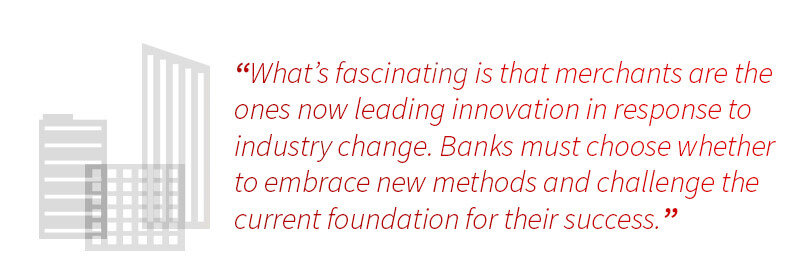Insider Analysis Helps eCommerce Merchants Increase Future Profitability
Do you want to know where the eCommerce environment is headed in 2017? Chargebacks911® has compiled the most comprehensive, no-holds-barred account of the payments industry and what can be expected in the next 12 months.
Monica Eaton, COO of Chargebacks911 and a highly-respected industry thought leader, shares invaluable insider information in order to better equip merchants for future prosperity.
1. What will be some of the biggest disruptions to the status quo for risk management in 2017?
I think in 2017, we will take a big step toward addressing a lot of the chaos and inefficiency the industry has coped with for the past few years. The patchwork of technologies and regulations that currently define eCommerce will be challenged for their continued role within our growing infrastructure.
First, we will see merchants focus much more intently on refining their fraud technologies, with a goal to improve front-end authorization. Merchants have seen the percentage of total revenue dedicated to fraud and chargebacks rising steadily for the past several years, and it’s becoming too big of a problem to keep brushing aside. As they do this, they’ll discover inefficiencies they’ve either ignored or failed to recognize–which have been siphoning profits for years.
Merchants will come around to the concept that they need a variety of tools and insights to address a plurality of threats. On-Demand solutions will continue to challenge the efficiency of in-house teams and more merchants will adopt the idea of outsourcing—in full or at least partly.
I think we will also see merchants engage more actively in dynamic load balancing. While this practice was once frowned upon by the industry, it’s proved to be a workable solution to help mitigate fluctuation in acceptance rates. With globalization at the forefront, static solutions will fall short.
2. What impact will FinTech have on fraud prevention in 2017?
The industry is changing rapidly, and FinTech continues to be one of the most disruptive influencers. Adherence to outdated standards and technology will be detrimental to businesses. Instead, those who understand new technologies best will be the most successful.
What’s fascinating is that merchants are the ones now leading innovation in response to industry change. Banks must choose whether to embrace new methods and challenge the current foundation for their success. Customer behavior is shaping eCommerce and the trickle-down effect on banks is inevitable. As mobile commerce grows, so does the demand for banking apps; financial institutions who choose not to get on board will find themselves left in the dust.
Learning from our collective past, 2017 will be the year we challenge our current standards—status quo meets responsive innovation!
 3. How will reason codes—and the industry’s reliance on them—change over the next 12 months?
3. How will reason codes—and the industry’s reliance on them—change over the next 12 months?
Chargeback reason codes will face more backlash and more challenges in 2017. I expect that we will soon see the reason code system re-introduced with some kind of check-and-balance mechanism intended to measure the accuracy of the designated reason.
However, even with several overhauls of the reason code system, the lack of source intelligence and overall transparency will cause merchants to lose more faith. Cottage Industries created to leverage this scenario will face reform as more and more merchants push back due to the rise of friendly fraud.
4. What do you hope to see happen in 2017?
First and foremost, I hope to see a genuine push for greater standardization between acquirers and issuers. At present, coordinating disputes and other interactions is made more difficult by the fact that there is no baseline standard for all parties; each is left to establish its own definitions and enforce the way in which it interprets regulations.
That goes hand-in-hand with greater transparency in the dispute process. Right now, merchants have very little insight into what goes on behind the scenes between submitting a dispute and receiving a judgement from the issuer. Complicating this issue is the addition of government and trading bodies. I’d like to see 2017 be the year where the industry as a whole collaborates, considering the cause and effect to each party. We need to study more about the problem in order to establish a solid solution.
5. What do you hope to avoid in the next 12 months?
One problem I noticed quite a bit in 2016 was the drive for ever-stronger and more stringent authentication. Strong Authentication is obviously important, but it seems like the industry is hyper-focused on that one subject at the expense of many other areas of eCommerce. Piling on more and more authorization checks doesn’t necessarily lead to a safer transaction; the only thing excessive security of this sort is guaranteed to do is hurt conversion by creating transaction friction.
Speaking of misguided intentions, I also would like to see less friction between legislation and the schemes. Too often, government bodies create and mandate new rules without thoroughly considering the valid arguments on both sides.
 6. Will EMV migration in the US continue to stall?
6. Will EMV migration in the US continue to stall?
Yes—in fact, this is a perfect example of what I was just talking about. The process was never fully thought out from the merchant’s perspective, because switching to EMV required much more from merchants than simply upgrading their card terminals. For many, converting to EMV chip readers represents a barrier that is simply too daunting to approach, leaving a lot of merchants with no choice but to accept liability for fraud.
Believing that merchants could adopt EMV by October 2015—or even 2016 for that matter—was far too ambitious a goal. Hence, the card networks announced they were going to push back the liability shift until 2020 for automated fuel dispensers.
EMV adoption is not going to be complete by 2017, and probably not by 2018, either.
7. What will be the most prominent fraud targets going into 2017?
A lot will change from one year to the next, but there are certain fraud traits that seem to remain constant. As always, fraudsters will go after targets which are high dollar value and easy to translate into cash. In addition, items which tend to be emotional purchases can also be hot targets for friendly fraud.
Items and services which will be most at-risk include:
- High-end apparel, jewelry, and accessories
- Gift cards
- Event and travel tickets
- Consumer electronics
- Online gaming
- Subscription and recurring billing services
8. How does this position Chargebacks911 for 2017?
Above all, we plan to focus our approach on enterprise-level needs and new technologies to identify and counter friendly fraud. We’ve managed to remain on the forefront of emerging trends through our own diligent efforts, and that’s what has allowed us to predict industry changes thus far with such accuracy.
We don’t plan to just sit on this information; instead, we’re going to use our expertise to continue rolling out new solutions based on anticipated need. We target developing threats so that we have a solution ready by the time the problem becomes a mainstream concern.
Optimizing Profitability in 2017 and Beyond
The payments industry is a dynamic environment—but that doesn’t mean it is impossible to get a step ahead. Scalable, agile, proactive solutions are available. If you are unsure if your current outlook on the eCommerce environment is accurate or you are concerned there are unrealized opportunities for profitability, contact Chargebacks911 today.
Don’t wait until next year or even next month to address potential concerns. Go on the offensive now, and start reaping the rewards.










